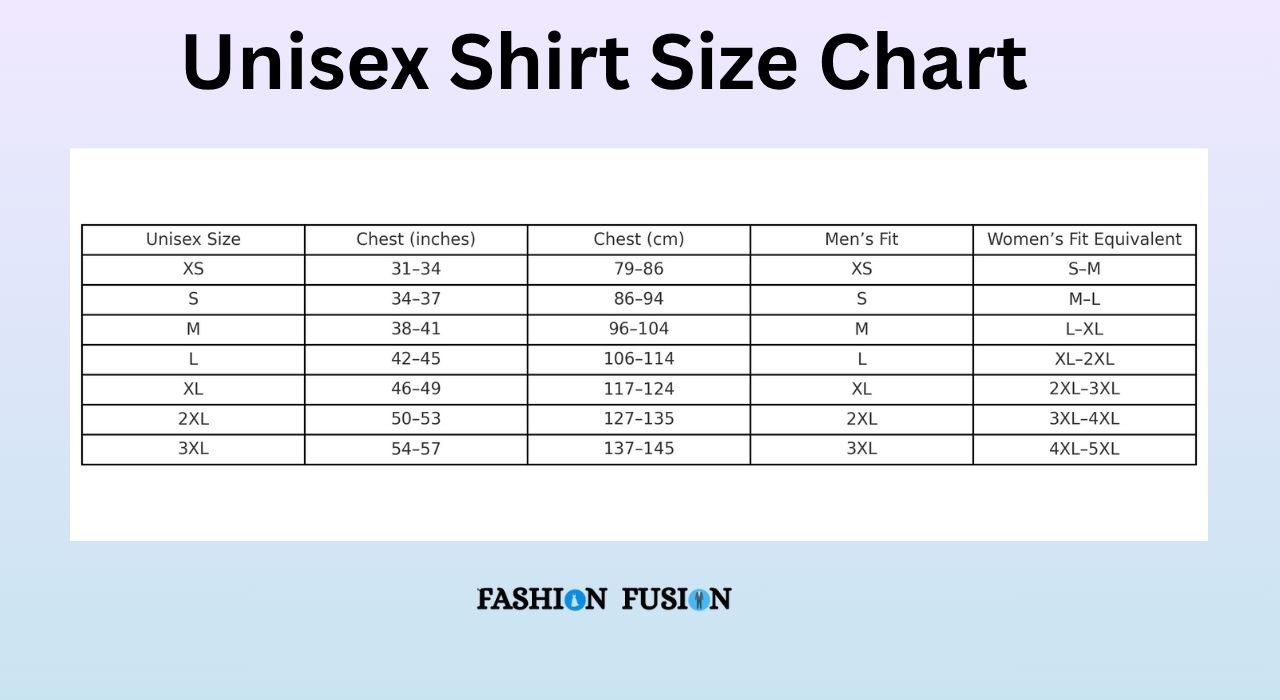Ever bought a unisex shirt and wondered, “What size am I even supposed to get?” You’re not alone.
With the rise of gender-neutral fashion, unisex clothing has become a go-to for comfort, versatility, and style. But sizing can be tricky — especially if you’re used to men’s or women’s specific fit guides.
In this post, we’ll break down what unisex shirt sizes really mean, how to read a unisex shirt size chart, and how to find your perfect fit — no matter your gender, shape, or style.
2. What Are Unisex Shirt Sizes?
Unisex sizing is designed to accommodate a broad range of body types with a single sizing system. However, in practice, most unisex apparel is simply based on men’s sizing standards.
This means:
- Men can usually buy their regular size.
- Women may need to size down for a better fit.
- Non-binary folks may find unisex cuts more neutral or boxy, which can suit their style preferences.
Why is unisex sizing based on men’s sizing?
Historically, “unisex” clothing was introduced during minimalist fashion trends and was often just men’s clothing marketed as gender-neutral. As a result, many unisex shirts still follow the same patterns and measurements found in men’s garments.
3. Unisex vs Men’s and Women’s Shirt Sizes
Here’s how unisex sizing compares to traditional men’s and women’s shirts:
| Feature | Men’s Shirt | Women’s Shirt | Unisex Shirt |
|---|---|---|---|
| Cut | Broad shoulders, longer torso | Narrower waist, shorter torso | Straight cut, roomy and boxy |
| Fit Intent | Relaxed or standard fit | Tailored, closer to body | Looser, androgynous fit |
| Sizing Base | True to size for men | Runs smaller than men’s sizes | Follows men’s sizing |
Tip: Women may find unisex shirts longer in the torso and sleeves, while men typically experience a standard or slightly relaxed fit.
4. Standard Unisex Shirt Size Chart
Use this unisex shirt size chart to help determine your best size. Always check the specific brand’s chart when shopping, as sizes can vary slightly.
| Unisex Size | Chest (inches) | Chest (cm) | Men’s Fit | Women’s Fit Equivalent |
|---|---|---|---|---|
| XS | 31–34 | 79–86 | XS | S–M |
| S | 34–37 | 86–94 | S | M–L |
| M | 38–41 | 96–104 | M | L–XL |
| L | 42–45 | 106–114 | L | XL–2XL |
| XL | 46–49 | 117–124 | XL | 2XL–3XL |
| 2XL | 50–53 | 127–135 | 2XL | 3XL–4XL |
| 3XL | 54–57 | 137–145 | 3XL | 4XL–5XL |
5. How to Choose the Right Size
Here’s how to make the best decision based on your identity and style preference:
For Men:
- Order your usual men’s size.
- Expect a standard fit or slightly boxy feel depending on the brand.
For Women:
- Size down one size for a casual fit.
- Size down two sizes for a fitted look.
Example: Women’s L → Unisex M (relaxed), Unisex S (fitted).
For Non-Binary or Genderqueer Individuals:
- Choose based on chest measurement and how you want the garment to drape — loose, standard, or snug.
- Unisex shirts can be great for avoiding overtly gendered silhouettes.
6. Fit Considerations for Different Body Types
Let’s dive deeper into how unisex shirts wear on different body shapes:
- Petite Frames: Shirts may feel oversized or long. Consider knotting at the waist, tucking into high-waisted pants, or cropping the hem for balance.
- Curvier Bodies: The fit may be tight across the chest but loose around the waist. Consider layering over fitted tanks or styling with belts to define shape.
- Tall Builds: Unisex shirts are often longer in torso and sleeves, making them great for tall wearers.
- Broad Shoulders: The boxy cut accommodates wider frames without looking overly tight.
Style Tip: Pair oversized unisex tees with fitted bottoms or structured jackets to balance proportions.
7. Unisex Sizing in Youth & Plus Sizes
Youth Unisex Sizes:
- Usually labeled by age or chest size.
- Looser than gendered youth sizes, great for playwear and school uniforms.
Plus Sizes:
- Many brands now offer unisex sizes up to 5XL or more.
- Since the cut is based on men’s sizing, plus-size women might find them roomy but not shaped for curves.
- Look for brands that offer extended unisex size charts for better fit.
8. Buying Tips for Unisex Shirts
Before you shop, keep these tips in mind:
- Always check the brand’s size chart — sizing can vary by inches.
- Measure your chest around the fullest part for accuracy.
- Expect shrinkage if it’s 100% cotton — size up if in doubt.
- Try it on or buy from stores with flexible return policies.
- Experiment with styling (tucking, knotting, layering) to personalize the look.
9. Frequently Asked Questions (FAQs)
Q1. Should I size up or down in unisex shirts?
-
Men: Stick to your usual size.
-
Women: Size down 1–2 sizes depending on fit preference.
Q2. Do unisex shirts shrink?
-
Yes — particularly cotton ones. Look for pre-shrunk materials or wash carefully.
Q3. Are unisex shirts flattering on curves?
-
They can be! Use styling tricks like tucking or adding accessories to shape the silhouette.
Q4. Can I tailor a unisex shirt?
-
Absolutely. A basic tee can easily be taken in, shortened, or reshaped by a tailor.
10. Conclusion
Unisex shirt sizing is meant to simplify fashion — but only if you understand how it works. By knowing how it compares to men’s and women’s sizes, using a size chart, and paying attention to your own measurements, you can find your best fit with ease.
Whether you love the oversized streetwear look or prefer a cleaner fit, unisex shirts are a versatile staple that suit everyone.

